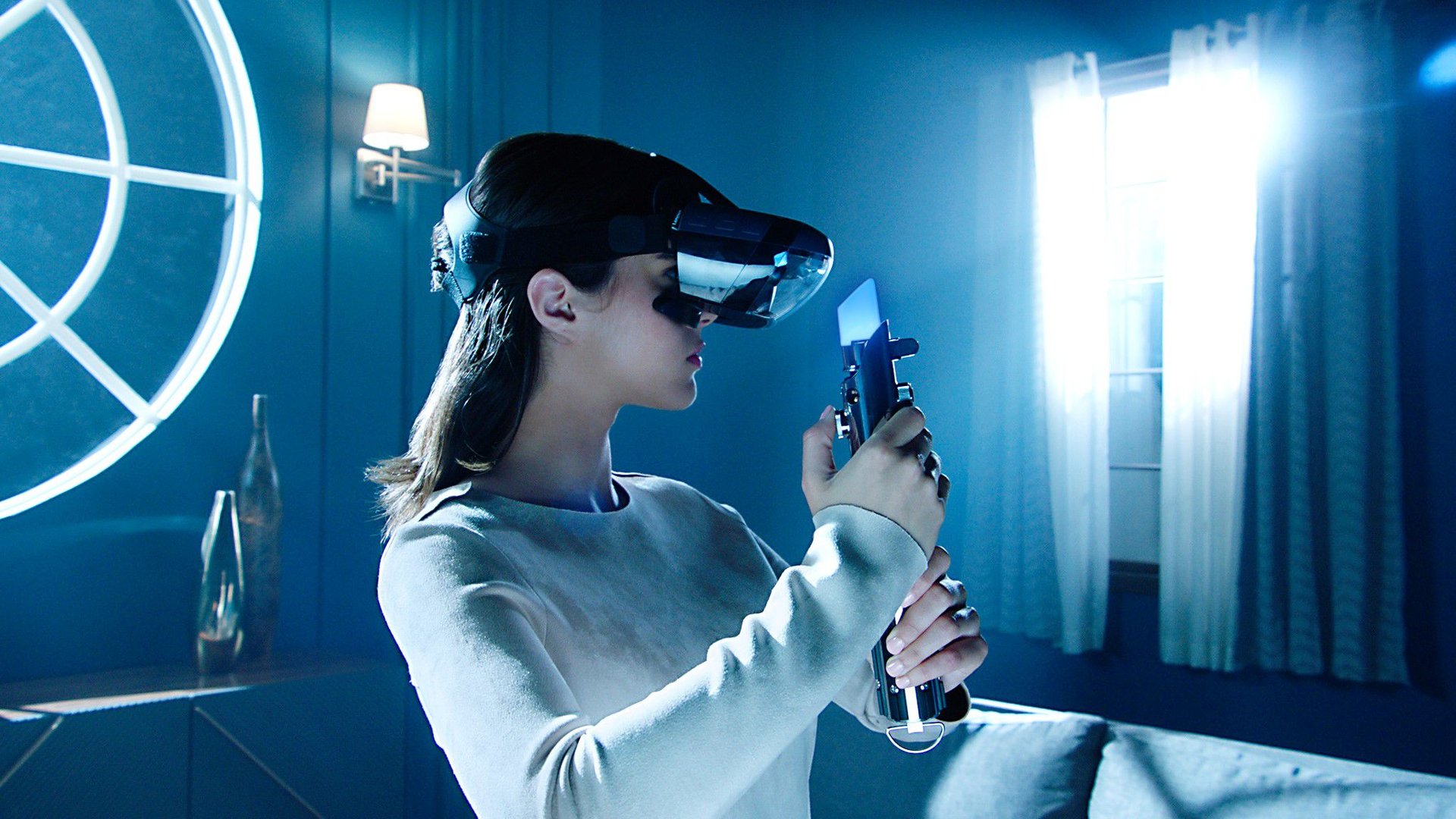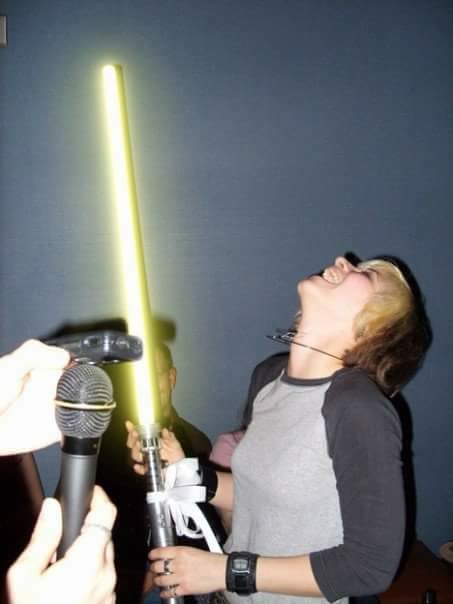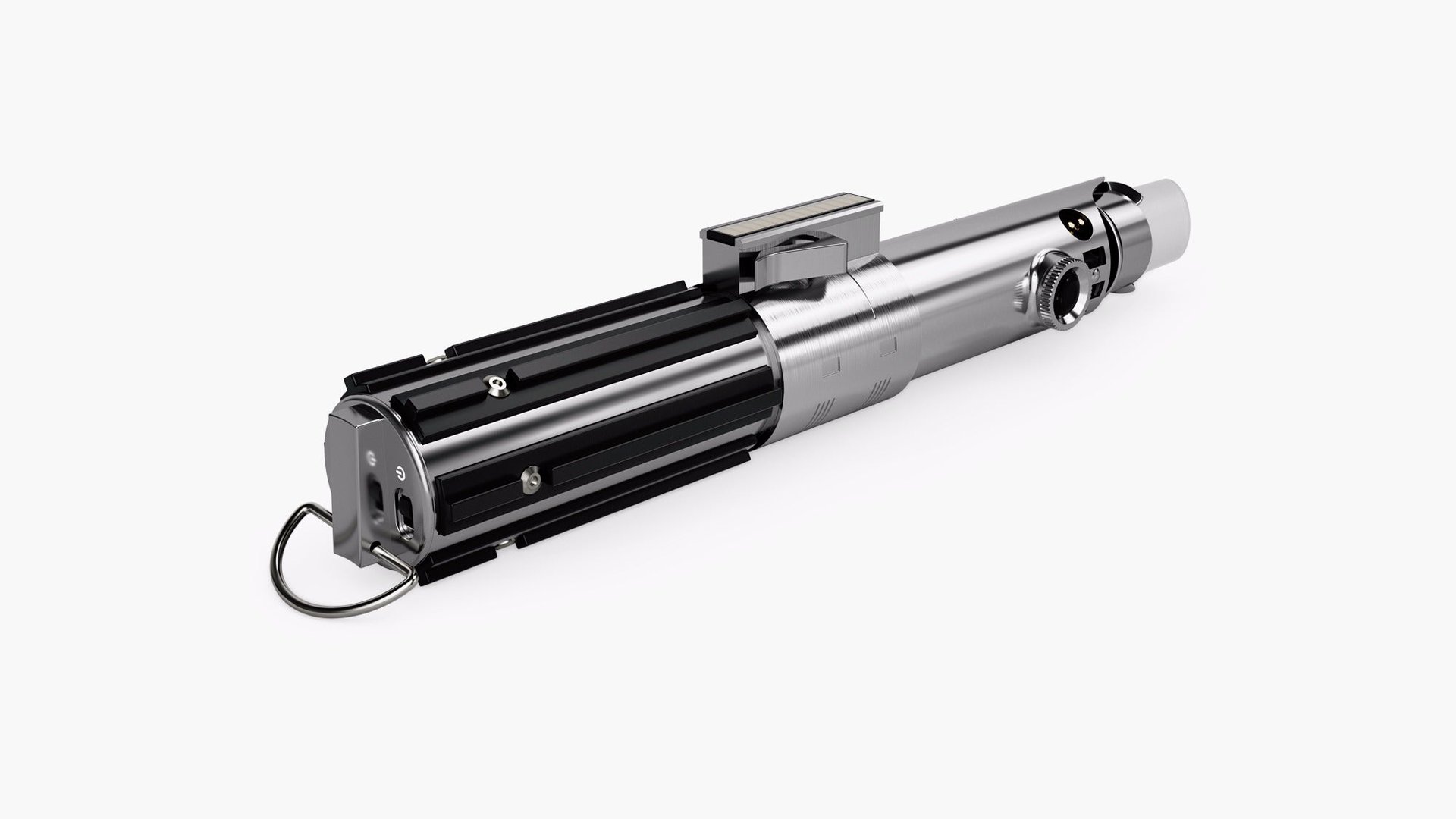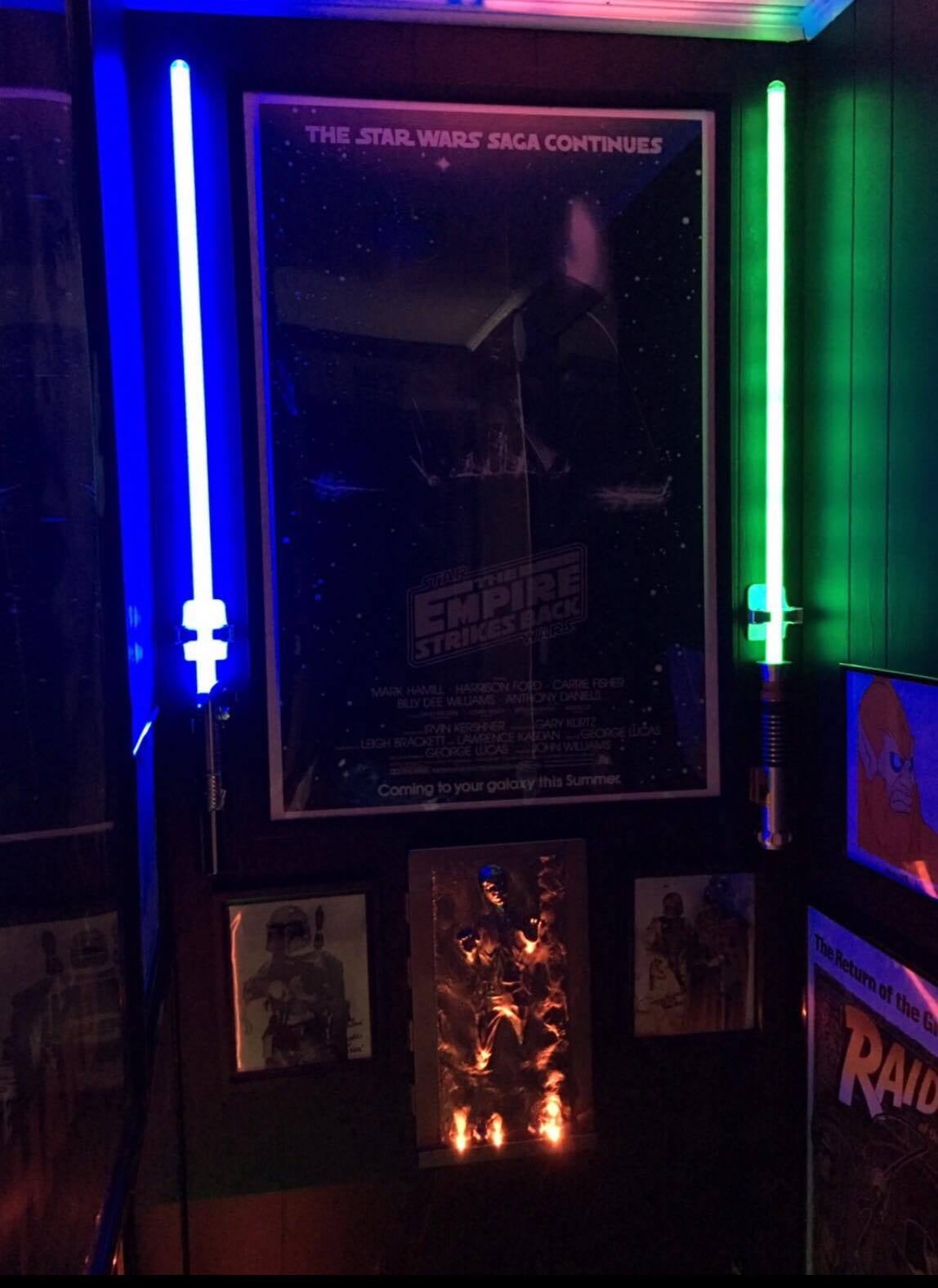Bringing the lightsaber from Star Wars—the ultimate toy—to life
Like many American children of his generation, Mike Goslin grew up watching Star Wars. He saw the first movie in theaters when he was a boy, and remembers the seminal moment in A New Hope when Obi-Wan Kenobi introduced the lightsaber. As Kenobi described it to Luke Skywalker: “This is the weapon of a Jedi Knight. Not as clumsy or random as a blaster. An elegant weapon, for a more civilized age.”


Like many American children of his generation, Mike Goslin grew up watching Star Wars. He saw the first movie in theaters when he was a boy, and remembers the seminal moment in A New Hope when Obi-Wan Kenobi introduced the lightsaber. As Kenobi described it to Luke Skywalker: “This is the weapon of a Jedi Knight. Not as clumsy or random as a blaster. An elegant weapon, for a more civilized age.”
Goslin, like so many kids, wanted a toy version. But he was unhappy with the that he found in stores. “Back in the day, the lightsaber toys were pretty junky,” Goslin told Quartz. “They didn’t look great… I wanted it to look more like it did in the movie.”
He vaguely remembers fashioning his own from objects found around his parents’ house. He modeled his after Luke’s first lightsaber. The one with the blue blade that was given to him by Kenobi and that, 30 years later, Rey wields in the latest trilogy. Now, Goslin is doing what he used to do, but on a totally different scale and for a whole new generation of kids.
He now works at Disney and set out to make the most realistic lightsaber that could be produced for a mass audience and sold in stores today. “If you think, ‘What are the experiences that I want to have from Star Wars,’ the first one that comes to mind is, ‘I want to have a real lightsaber,'” said Goslin, vice president of advanced development at Disney, building products and experiences based on brands like Star Wars.
The result was an augmented-reality (AR) experience, Star Wars: Jedi Challenges, that uses a Lenovo-branded headset, a lightsaber controller, a tracking ball, and a smartphone to simulate the weapon of a Jedi Knight. It uses your phone’s screen and the headset’s cameras and sensors to overlay Star Wars characters and scenes to battle against in a series of mini-games, said Quartz’s Mike Murphy, who called it the closest you’ll get to feeling like a Jedi Knight.
It costs about $200, and was released ahead of the newest Star Wars saga film, The Last Jedi, which is out this week. It is one of the hottest Star Wars toys for the holidays.
The allure of the lightsaber
Anyone who has stood in line for a Star Wars movie or gone to a comic convention has probably met someone who made a lightsaber of their own. Some build them from scratch. Others buy the parts and assemble it themselves. The act emulates a sacred rite of passage for young Jedis in training. Younglings, or children with the Force, mine their own Kyber and build their own lightsabers when they advanced to Padawans, or Jedi apprentices. The Force-attuned crystals power the Jedi weapons.
“It’s never just about a lightsaber,” said Katalena Mermelstein-Knox, a Star Wars fan who has a custom lightsaber (not self-made) and met her husband at New York Jedi lightsaber classes. “It represents an emotional journey… That’s why something that came out in 1977 is still hyper-strong today. It’s because of this one particular weapon, this crazy laser-sword, that has such a draw, such an element of power, and fantasy, and science fiction all rolled into one. “

Part of the fascination with the lightsaber stems from its blend of history, science, and fantasy. With a hilt and a blade, Star Wars creator George Lucas harkened back to legendary weapons of old, like King Arthur’s sword. The blade being made of light adds an element of technology to it. Yet it defies the laws of physics. Light cannot extend three feet and stop without anything to reflect the light back. And light generally does not interact with light the way that two lightsabers do in battle. It’s magic, or rather, the Force, that enables it.
Brian Clegg, in his book, Ten Billion Tomorrows: How Science Fiction Technology Became Reality and Shapes the Future, says that “everyone who knew anything about physics knew they were impossible.”
“Star Wars always was fantasy,” he added in an email to Quartz. “It’s essentially a fairy tale with magicians and magic swords given a science-fiction gloss.” That hasn’t stopped people of dreaming up of versions of the lightsaber that could exist in real life.
It’s been recreated in countless toys over the past 40 years, from the original 1978 model by now-defunct toymaker Kenner, which was basically a flashlight with an inflatable vinyl blade affixed to it, to modern replicas from companies like Hasbro with blades lit by LED lights and motion-sensing sound effects that can run for as much as $200. There are cheaper models, too. You can build your own lightsaber in some Disney parks. The weapon is featured in Star Wars video games like Star Wars: Battlefront. And it’s a pivotal part of experiences like the “Trials of Tatooine” virtual-reality demo from Lucasfilm’s ILMxLAB.
There are unofficial iterations as well. Custom sabers that are durable enough for combat and have tailored lights and sound effects start at $55 and climb to more than $500 from companies like UltraSabers. A fan recently built an AR app that turns rolled-up pieces of paper into lightsabers. And there are those lightsaber classes, like Mermelstein-Knox took, in places like New York and San Francisco.
“They are the ultimate toys,” Clegg wrote. ”Take away the unpleasant effects of slicing through flesh and who wouldn’t want to take part in a lightsaber battle, clashing insubstantial glowing blade against blade to a soundtrack of that glorious ripping buzz?” Some of the earliest lightsaber toys hummed or whistled in imitation of it when you swung them.
Ben Burtt, who created it and other Star Wars sounds, told Fast Company it was the first sound ever designed for the Star Wars films. It was captured by mixing recordings of old movie projectors and the interference from an unshielded microphone with an old TV tube.
Today, higher-end models, like those made by Hasbro or customized by companies like UltraSabers, played a range of sounds.
Fans who made their own had to get creative. ”As a child growing up in the 1970s and 1980s, and obviously a big Star Wars fan, I loved playing with the lightsabers,” Keith Wehr, a Star Wars collector from New York who has about 20 lightsabers, tells Quartz. “A wiffle-ball bat was my first ‘lightsaber’ and I would make my own sounds. Then Kenner finally made ‘real’ lightsaber toys. They would make the sound for you as you swung them.”
How to make a lightsaber in 2017
All the challenges of building a lightsaber today, for the sophisticated kids who would pick them up, were compounded by the fact that Disney had to create something with a price point that would woo the average fanboy or girl to splurge, and overindulgent parents to buy for their children.
They settled at around $200.
“We thought it was a scalable mass-market price point,” said Goslin. The team had to make some trade offs to make that work. For example, the current version does not support multiple players, which is something Disney is still working on. But they also had to work on the things that fans really cared about—such as the sound.
Goslin and his team did extensive research on the sounds lightsabers make when they’re swung for an earlier, never-released lightsaber product for Disney, which was audio only. They used that, and the lightsaber audio directly from the movies, from Lucasfilm, to create the sounds heard in the game. There’s a unique buzz for each way the lightsaber moves. And it’s three-dimensional, so if you’re wearing headphones while using the device, the humming sounds as if it’s coming from the part of the room that it’s meant to be in.
“Depending on how fast you’re swinging, whether you’re swinging towards you or away from you, where you’re holding it, and whether you’re in contact with something, the sound will change,” Goslin said.

And then there is the blade—one of the hardest aspects of the lightsaber to recreate because there’s nothing like it that exists in real life. It’s also the most crucial.
The blade of the 1978 toy lightsaber was made of inflatable vinyl that deflated when swung too hard. It came with a patch kit for the inevitable repairs. Later models were made of plastic tubes, some of which extended out. Wehr, one of the Star Wars fans, recalled that he and has brother dueled with one of them until they broke from overuse. In the 2000s, toymakers like Master Replicas began incorporating LED lights into the plastic blades to make them brighter. But the LEDs would pop if they hit hard enough against another lightsaber and leave gaps in the light. They weren’t ideal for combat.
Companies like UltraSabers, which does not make official Star Wars replicas, eventually started using polycarbonate, a very strong plastic, which was safer to duel with. The polycarbonate that UltraSabers uses can withstand over 50 pounds, a spokesperson told Quartz. Its hilts are made of aircraft-grade aluminum. Still, it can’t quite capture the experience of wielding a weapon truly made of light, like in the films.
“It’s a little unsatisfying to have a hilt with a tube of plastic coming out of it that’s illuminated internally,” said Goslin. “It’s not the same. It’s not as good as having one that looks like it does in the film.” Disney thought AR was the best thing available that could recreate that.
Jedi Challenges, the AR game, relies on an LED light placed at the end of the physical hilt to tell the virtual blade where it needs to go. It’s aided by a sensor inside the hilt—with an accelerometer, gyroscope, and magnetometer—that helps with orientation and motion, and cameras and sensors inside the headset.
“The light on the end tells us the position,” said Goslin, “and we take all the other information and we use that place the virtual blade.”
Tracking the blade as the wielder moves was the hardest part. It took about two years and 70 prototypes to get right. The external tracking device marks of the place space for the game.
Since you’re (hopefully) not hitting anything tangible when playing, the hilt is outfitted with a haptic motor that vibrates when it turns on, and when it makes contact with something in augmented reality. That’s how you know if you’ve hit something. The motor also speeds up and slows down based on how the device moves. “There’s some real detail and nuance,” Goslin said.
Lucas originally conceived of the lightsaber as a very heavy weapon, around 40-50 pounds, that was meant to be held with two hands, according to Fast Company. Luke’s ability to later wield the weapon with one hand was a testament to how far he’d advanced in his Jedi training.
As such, most good lightsaber toys and replicas are hefty. The hilt on the Jedi Challenges experience is made of plastic, so the team at Disney added weight to the device. Not so much that it’d be tiresome to play with, but enough so that it didn’t feel flimsy. They also used a chrome finish—using the same process for making mobile phones—to make the plastic look metallic, Goslin said.

Like Goslin’s make-shift childhood lightsaber, this AR one was modeled after Luke’s first weapon, which was crafted by his father, Anakin, and later found its way into Rey’s hands. Disney consulted with Lucasfilm, which makes sure all physical Star Wars products are authentic to how they look on screen. Devotees may know that the design used in The Force Awakens was slightly different from that in the earlier movies. The size of the dials and ridges on the device differ, for example, Goslin said. The AR game is true to the 2015 movie.
Disney is also hoping to take the technology beyond the living room. Disney’s consumer products and interactive division, which made the game, is in talks with its theme-park arm to bring the augmented-reality experience into Disney parks. “Nothing has been decided yet but we have big plans and we think that there’s a place for this kind of experience in parks as well,” Goslin said.
The company has been experimenting with new ways to incorporate the lightsaber into its parks as it develops new Star Wars-themed lands, which are set to open in 2019, and Star Wars-themed hotels. Disney Research filed a patent application last year that detailed a system of drones, laser beams, and other devices that could simulate a lightsaber experience.
There’s plenty of reason to keep experimenting as long as fans like Wehr and Mermelstein-Knox are around. Wehr has passed down his love of lightsabers, and Star Wars, to his children. His son has five or six lightsabers to add his father’s own impressive collection. And he and the family will be seeing the new movie together.
Mermelstein-Knox, meanwhile, who practically lived with her lightsaber from 2007-2009 when she was taking the lightsaber training classes and performed with her fellow Jedi Knights at comic conventions, birthday parties, and mall openings, has hung up her lightsaber, for now. She and her husband, who also has a custom-designed lightsaber, have a toddler in tow. They plan to introduce their son to the films when he’s old enough.
“I will look at him one day and I will say, yes, you are ready,” she said.
She has a brand new lightsaber toothbrush sitting in plastic for when he’s old enough for that, too.